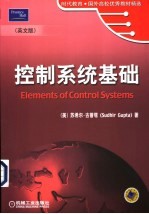图书介绍
控制系统基础PDF|Epub|txt|kindle电子书版本网盘下载

- (美)苏希尔·古普塔(Sudhir Gupta)著 著
- 出版社: 北京:机械工业出版社
- ISBN:7111147685
- 出版时间:2004
- 标注页数:573页
- 文件大小:18MB
- 文件页数:592页
- 主题词:控制系统理论-高等学校-教材-英文
PDF下载
下载说明
控制系统基础PDF格式电子书版下载
下载的文件为RAR压缩包。需要使用解压软件进行解压得到PDF格式图书。建议使用BT下载工具Free Download Manager进行下载,简称FDM(免费,没有广告,支持多平台)。本站资源全部打包为BT种子。所以需要使用专业的BT下载软件进行下载。如BitComet qBittorrent uTorrent等BT下载工具。迅雷目前由于本站不是热门资源。不推荐使用!后期资源热门了。安装了迅雷也可以迅雷进行下载!
(文件页数 要大于 标注页数,上中下等多册电子书除外)
注意:本站所有压缩包均有解压码: 点击下载压缩包解压工具
图书目录
1 BASIC CONCEPTS1
Introduction1
Control Terminology1
出版说明4
序5
PREFACE7
Functioning of a Control System 8
Examples of Closed-Loop Control Systems 9
Problems12
2 BLOCK DIAGRAMS13
Introduction13
Definition of a Block Diagram14
Summing Point15
Takeoff Point16
Block Diagram Representation of an Equation16
Block Diagram Representation of Control Systems17
General Transfer Function19
Transfer Functions19
Transfer Function of a Closed-Loop System20
Comparison of Positive-Feedback and Negative-Feedback Systems22
Unity Feedback Systems28
Conversion to a Unity Feedback System28
Block Diagram Simplification29
Op-Amp Simulation of a Block Diagram34
Summing Point35
Summing Point with Adjustable SP Input36
Gain Block38
Constant-Gain(Noninverting)Block38
Constant-Gain(Inverting)Block41
Takeoff Point 41
Summing Point with Multiple Inputs 42
Problems50
Transformations54
3 LAPLACE TRANSFORMS54
Introduction54
Laplace Transform Integral55
Transform Notation56
Rules of Transformation 56
Forward Transformation Procedure61
Inverse Transformation Procedure67
Partial-Fraction Expansion 79
Distinct Roots 80
Repeated Roots 81
Applications of Laplace Transforms:Difierential Equations 88
Problems93
4 MATHEMATICAL MODELING97
Introduction97
Mathematical Model98
Nonlinear Behavior98
Transfer Functions99
Electrical Networks100
Resistor101
Capacitor101
Inductor102
Series RC Circuit103
Series RL Circuit105
Series RLC Circuit107
Mechanical Systems112
Mass112
Spring113
Damper113
Spring Mass Damper System114
Analogy Between Physical Systems116
Fluid Systems117
Single-Tank Fluid-Level System117
Two-Tank Fluid-Level System119
Thermal Systems122
Heating Systems123
Problems124
5 TRANSIENT RESPONSE127
Introduction127
Time Response127
Input Functions129
Step Function129
Pulse Function131
Impulse Function132
Delayed Impulse Function133
Ramp Function134
Sinusoidal Function134
Types of Transient Responses135
Overdamped Response135
Underdamped Response136
Critically Damped Response136
Constant Oscillations137
Increasing Oscillations137
Exponential Rise138
Transient Response Through Laplace Transformation138
Impulse Function Response 144
Characteristic Equation 148
Poles and Zeros of the Transfer Function 151
s-Plane and Pole-Zero Map153
Pole Location and Transient Response155
Problems160
6 FREQUENCY RESPONSE162
Introduction162
Methods Used for Frequency Response Representation164
Frequency Response Determination166
Problems186
Introduction189
7 COMMON TRANSFER FUNCTIONS189
Common Blocks(Transfer Functions)191
Constant Block192
Time Response of a Constant TF195
Frequency Response of a Constant Block195
Integral Block198
Time Response of an Integral Block198
Frequency Response of an Integral Block200
Derivative Block203
Time Response of a Derivative Block204
Frequency Response of a Derivative Block204
The Relationship Between Integral and Derivative Blocks208
First-Order Lag Block208
Time Response to a Unit Step Input209
Frequency Response of a First-Order Lag Block213
First-Order Lead Block219
Frequency Response of a First-Order Lead Block220
Time Response to a Unit Step Input220
Second-Order Lag Block224
Time Response to a Unit Step Input225
Characteristics of Underdamped Response231
Frequency Response of a Second-Order Lag Block234
Second-Order Lead Block238
Time Response to a Unit Step Input240
Frequency Response of a Second-Order Lead Block240
Dead Time:Transportation Lag Block241
Time Response to a Unit Step Input243
Frequency Response of a Dead-Time Block243
Problems244
8 STABILITY248
Introduction248
Concept of Stability248
Stability and the Open-Loop Transfer Function252
Open-Loop Gain and Operating Frequency255
Stability from a Bode Plot259
Gain and Phase Margins261
Gain and Phase Crossover Frequencies261
Gain Margin(GM)261
Phase Margin(PM)263
Desired Gain and Phase Margins264
Stability from the Characteristic Equation269
Routh Criterion for Stability271
Root Locus Analysis278
Root Locus Through MATLAB281
Problems288
9 CONTROLLERS:THE ON-OFF CONTROLLER291
Introduction291
Role of a Controller291
Types of Controllers292
Use of a Percent as Input and Output293
Measured Value as a Percentage Value295
Set Point as a Percentage Value296
Error as a Percentage Value296
On-Off Control298
Types of On-Off Control298
Electronic Implementation(Analog)299
Two-Position Control303
Neutral Zone304
Controller Action306
Applications308
Electronic Implementation309
Multiposition(Floating)Control315
Problems315
Introduction318
Proportional Controller(P)318
10 ANALOG CONTROLLER Ⅰ318
Transfer Characteristic319
Proportional Band321
Relationship Between Percent Output and Physical Controller Output322
Electronic Implementation326
Frequency Response of a Proportional Controller332
Proportional Control of a Closed Loop334
Steady-State Operation with Zero Error339
Proportional Controller with Offset346
Offset Voltage Adjustment346
Integral Controller(Ⅰ)346
Electronic Implementation353
Limiting DC Gain354
Frequency Response of an Ideal Integral Controller355
Frequency Response of a DC Gain-Limited Integral Controller356
Derivative Controller(D)359
Electronic Implementation365
Frequency Response of a Derivative Controller366
Limiting High-Frequency Gain367
Problems375
11 ANALOG CONTROLLER Ⅱ378
Introduction378
Composite Controller Modes378
Serial Implementation379
Parallel Implementation379
PI Controller380
Electronic Implementation of a PI Controller383
Frequency Response of a PI Controller384
PD Controller391
Electronic Implementation of a PD Controller393
Frequency Response of a PD Controller395
PID Controller400
Electronic Implementation410
Frequency Response of a PID Controller 412
Changing the Operating Mode 412
Problems 417
12 DIGITAL CONTROLLER 420
Introduction 420
Digital Controller421
Controller Sequence of Operation 422
Considerations for Digital Control424
Digital Two-Position Control426
Sequence of Operation 426
Microcontroller Implementation of a Two-Position Controller 427
Digital PID Controller 433
Analog PID Algorithm 433
Digital PID Algorithm433
Zero-Order Hold(ZOH)435
Ideal Digital PID Algorithm 440
Discrete PID Algorithm—BASIC Language 440
Manual Control Mode 442
Velocity Algorithm 443
Improved Derivative Term 444
Microcontroller Implementation of a PID Controller 445
DC Motor Control 445
Control Software Description 448
Problems 453
13 FUZZY CONTROLLER 455
Introduction 455
Continuum World 455
Conventional Logic 457
Fuzzy Logic and Fuzzy Logic Terminology 457
Fuzzy Control System 475
Problem Identification 476
Conceptual Design 476
Problems 487
Introduction 491
14 CONTROLLER TUNING AND SYSTEM DESIGN 491
Controller Tuning 492
Performance Criteria 492
Controller Tuning:Known Plant Model 493
Plant Model from Experimental Response Testing 504
Step Response Test504
Graphical Analysis505
Computational Method508
Frequency Response Test511
Experimental Determination of Controller Setting518
Continuous Cycling Method518
Reaction Curve Method519
Case Study:Machine Positional Control System521
Drive Mechanism522
Position Transducer522
Problems 530
Feedforward Control533
15 ADDITIONAL CONTROL TECHNIQUES533
Introduction533
Disturbance Signal534
Ratio Control537
Cascade Control537
Autotuning Controller539
State-Space Techniques540
State Variables540
State Equations540
Transfer Function to State-Space Representation543
Problems545
BIBLIOGRAPHY547
APPENDIX A MATLAB549
GLOSSARY559
INDEX565